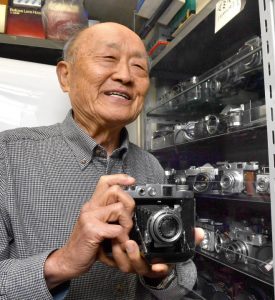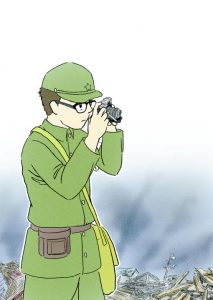Chugoku Shimbun creates realistic manga depicting Yoshito Matsushige, photojournalist who took photos of August 6 Hiroshima with pre-war camera
Nov. 15, 2022
Camera collector Hiroshi Sugahara cooperated in process with his expertise
by Minako Okuda and Keiko Watanabe, Staff Writers
The Chugoku Shimbun has produced a manga titled “Viewfinder blurred with tears” depicting Yoshito Matsushige (who died at the age of 92 in 2005), a former staff photographer for the Chugoku Shimbun. Mr. Matsushige took photographs of Hiroshima on the day of the atomic bombing. The project was planned to coincide with the Chugoku Shimbun’s 130th anniversary.
Mr. Matsushige also served as a member of the Imperial Japanese Army’s Chugoku District Military Headquarters news team. Immediately after the atomic bomb was dropped, he grabbed his camera and headed to downtown Hiroshima from his home in the area of Midori-machi (now part of the city’s Minami Ward). The five photos he took at Miyuki Bridge near his home are now considered valuable materials that convey the horrific scenes of Hiroshima on the day of the atomic bombing.
Mr. Matsushige felt that he had to take photographs to pass on to later generations, but he was unable to snap the shutter at times due to the horrific nature of what he was witnessing. By describing Mr. Matsushige’s conflict, Naoko Kubo, a manga artist living in Hiroshima’s Asaminami Ward, has put together a tender 17-page story.
Following the manga story titled “A-bombed city newspaper that worked to help the city orally, using its own voices,” first released this past summer, the new manga series represents the second volume in the series. In total, four volumes will be created and published in the format of a book titled “Manga: The A-bombed city newspaper” by the end of this year.
Hiroshi Sugahara, 83, a camera collector living in Hiroshima’s Nishi Ward, cooperated in the creation of drawings for the manga “Viewfinder blurred with tears.” The camera that Mr. Matsushige carried with him at that time was the Mamiya 6, a domestically produced bellows-type camera. Because Mr. Sugahara owns the same camera, which was produced before the war, he helped with completion of the detailed descriptions used in the manga by drawing on his deep knowledge of cameras.
The Mamiya 6 first went on sale in 1940. Before the war, the camera was characterized by the shape and number of viewfinders on the front of the body, which differed from the cameras produced in a post-war product series. The pre-war camera employed a unique, long back-focus mechanism that enabled the camera to adjust the focus through movement of the film surface back and forth. Mr. Sugahara said, “Due to that focal system, it was easy for photographers to use the camera to take vivid photos.” The Mamiya 6 camera owned by Mr. Sugahara is 11 centimeters in height and 14.5 centimeters in width, weighing in at 750 grams. The camera was compact but sturdy, making it ideal for carrying.
Soon after the war ended, Mr. Matsushige developed photos from the original negatives he had taken at the time of the bombing and hung onto them. Meanwhile, he replaced the camera he had been using to purchase a new one. The second camera he used, a post-war Mamiya 6, has been donated to the Hiroshima Peace Memorial Museum, located in the city’s Naka Ward.
In creating the manga depicting Mr. Matsushige, the Chugoku Shimbun asked Mr. Sugahara for his help, because he owns about 3,500 cameras including those made during Japan’s Showa era (1926-1989) and has published a book on cameras. The manga artist Naoko Kubo said, “Mr. Sugahara’s support has added a sense of reality to the manga I created. I think readers will be able to sense the atmosphere of those days ever more vividly as a result.”
Mr. Matsushige’s five photographic negatives have been designated important tangible cultural properties by the Hiroshima Municipal Board of Education. The photos developed from those negatives are now on display in the lobby on the first floor of the Chugoku Shimbun headquarters building, located in Hiroshima’s Naka Ward. Mr. Sugahara’s camera is to be added to that display soon. Mr. Sugahara witnessed the cloud arising from the atomic bombing when he was six years old from his hometown in present-day Akitakata City. He hopes that “people understand also through the exhibited camera the feelings of Mr. Matsushige, who worked so hard to take the photos at that time.”
(Originally published on November 15, 2022)









